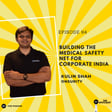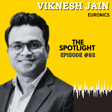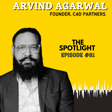Become a Creator today!Start creating today - Share your story with the world!
Start for free
00:00:00
00:00:01

Building the energy storage cloud | Ankit Mittal @ Sheru
Internal Combustion engine vehicles are on their way out, and soon all vehicles will be electric. For commercial EVs, it's smarter to swap batteries than wait for them to charge due to limited charging stations and the need for constant vehicle uptime. Sheru is a disruptive EV startup focused on swapping EV batteries and providing energy storage solutions for power companies.
For more such interesting founder journeys, subscribe to our newsletter www.founderthesis.com
Transcript
The Rise of Electrification and Battery Swapping
00:00:00
Speaker
Hey, this is Ankit, the co-founder and CEO of Shadoop.
00:00:14
Speaker
Internal combustion engine vehicles are on their way out and it's only a matter of time before all vehicles on the road are electrified. This brings with it a unique set of allied opportunities and one such opportunity is the space of energy storage. In the commercial EV space, battery swapping rather than battery charging makes a lot more sense. This is because of the lack of charging infrastructure and the need for zero downtime with commercial vehicles.
00:00:43
Speaker
Sheru is a disruptive EV startup that operates in the intersection of battery swapping for EV vehicles and energy storage solutions for power producers and distributors. Stay tuned as your host Akshay Dutt interviews Ankit Mittal, the founder of Sheru, about the opportunity in energy storage and Sheru's fascinating journey in this space.
00:01:13
Speaker
So first, can you give an elevator pitch of what is safe? So at Sheru, broadly, we are building cloud energy storage so that we can support green
Cloud Energy Storage Explained
00:01:23
Speaker
electricity. How does cloud energy storage work? When we think about cloud computing or cloud energy storage, what we're saying is, first of all, we are decoupling the infrastructure required to perform computing and energy storage from the user and the business. Also, we are making the entire experience of availing this service virtually.
00:01:42
Speaker
so that the user has to just simply think about what kind of capacity they require.
00:01:48
Speaker
in what format they want to use the capacity, specify how they want to schedule it, how they want to pay for it, all those things. And even so to say, create virtual instances, create sandboxes for different applications. So in cloud computing also, there is infrastructure. It's not like that the infrastructure is not there. And infrastructure can be present in multiple formats. It can be present in centralized formats and can be even aggregated through multiple sources.
00:02:19
Speaker
But it's the same thing that we are doing in cloud energy storage also. Today, we are focusing on aggregation more because the current requirement of grid is too high. We are at a stage where 20 gigawatt hour energy storage is required in India, and we have less than 40 megawatt hour built out. It's like a 99% under supply. So right now, the priority is just to get as much capacity as much possible from whichever source, network it all together, and make it available to the grid so that grid can do on-demand energy storage.
00:02:48
Speaker
How are you finding storage? So you're saying that only 40 megawatt is currently available out of a requirement of 20 gigawatt. So from where are you finding more waste storage?
India's Energy Storage Needs and Sheru's Role
00:03:03
Speaker
So electrification is also impacting a lot of other sectors also. For example, mobility is going completely electric. Electric mobility is a talk of the town. In electric mobility also there are certain categories which are growing faster
00:03:21
Speaker
in India than other categories. So, we have electric two and three wheelers growing much faster than electric cars or electric buses in India for a very simple reason. I mean that's two and three wheelers are the majority vehicle population in India. They are shifting to electric
00:03:38
Speaker
And in that space also, the majority of the adoption today is coming in from the bottom of the pyramid, which is involved in any kind of wide healing or gig economy related work. So they are shifting to EVs for a 50% cost benefit. And they are doing it in a very interesting way. They are not buying batteries along with the vehicle, or even if they are buying it for the first time, they're not buying it for the second time.
00:04:06
Speaker
And they are more operating on battery subscriptions. And that has created a lot of battery swapping capacity in the market, which is what we are aggregating today. Now, going forward, we see this only compounding. We have around 13 megawatt hour aggregated today. We see that in the next 18 months, we'll have like 100 megawatt hour plus.
Collaboration with DISCOMs and Revenue Model
00:04:30
Speaker
And that's what the goal is also.
00:04:34
Speaker
But broadly, this is the first category that we are aggregating, but there are a lot of other categories also. For example, we have some pilots going on with electric bus OEMs also. In India, buses are also public transport. They are also going to grow in a very big way in the next three to four years. So a lot of battery capacity can be borrowed from electric buses as well.
00:04:55
Speaker
Even in electric buses, there are different categories. School buses have different idle time. Intensity buses have different idle time. Intensity buses have different idle time. And as a result, different supply is available. Different kind of supply is available from different categories at different time points.
00:05:15
Speaker
So the bus piece here is essentially the bus itself becomes a place where energy is stored. Yes. And the battery swapping providers, those battery swapping providers become a source of energy storage because they would have racks with batteries which are getting charged and then put into scooters. So that rack full of batteries can become a smart storage device. Yes. Okay.
00:05:38
Speaker
What is the split the money here? Who pays and who or do you pay? Like between the stakeholders, how is this monetized? So we are getting bit by discoms.
00:05:50
Speaker
We are working with BSCAs, we are working with TPDDL, we are working with a bunch of more DISCOMS. They pay us for the energy storage and then we spend the revenue that we achieve from providing the service to DISCOMS between us and the source of the battery.
00:06:12
Speaker
A dollar was generated from X kilowatt hours of energy storage space that we provided our disk comp. So that dollar will be split 50-50 in us and the source of that battery capacity. So that is something that we are constantly tracking whose battery capacity are we using for how long.
00:06:28
Speaker
and according to that time and according to that participation. So it's very clear that this particular battery capacity participated for how long in generating this dollar and based on that we are able to very easily divide the money coming to us with the suppliers as well.
00:06:44
Speaker
The way to monitor a stock could be two ways. You could, for example, buy energy when it's cheap and sell it when it's expensive. I believe based on time of day, the pricing, like this dynamic pricing. So that could be one way. Or you're just providing this as a subscription service. How exactly do you?
00:07:04
Speaker
Somewhere in the middle. So we are not doing energy arbitrage. We are not buying and selling electricity at variable prices. What we are doing is we are saying that we have storage space. You can benefit from energy arbitrage. You benefit from it. We want you to make money from it. We just want to enable that and for that we are providing the storage space.
00:07:35
Speaker
And you can pay for that storage space on demand. You don't have to take that storage space on a subscription from us. You can completely pay for this on a per electricity unit basis. And you can completely do it on demand. So it's neither a subscription that we are charging from them. We don't want to do long-term contracts with discounts. I mean, there's no point of doing those. Of course, we don't want to get into our energy arbitrage also.
00:08:05
Speaker
Energy arbitrage is something that's one of the applications of energy storage. There are many more applications of energy storage. There's frequency regulation, voltage regulation, flexible ramping, black start operations, spinning reserves, lot of applications, transmission congestion relief.
Energy Arbitrage and Market Dynamics
00:08:22
Speaker
A lot of them are, see when a DISCOM is operating, there are three functions that they are playing. First function that they are playing is of managing the infrastructure.
00:08:33
Speaker
Second function that they are playing is of a distributor. Third function that they are playing is of a retailer. So, they are playing three functions and all those three functions have different requirements of energy storage. According to the requirement, they use, they warehouse the energy. Whatever time they want to warehouse it, they take it back and perform that function. And what we are seeing is that it's not all discomps that are interested in
00:09:04
Speaker
leveraging energy charge opportunities or exploiting those opportunities. In the entire energy value chain, power producers, transmission companies, EPC companies, DISCOMs, open access customers, at the end of the day, all of them are consuming electricity. The only value addition
00:09:28
Speaker
that anyone can know in anyone else's life is about availability and price. So, as electricity sector is shifting to more network sector, more tradable electricity, more conducive environment for tradability of electricity, basically this energy arbitrage opportunity is expected.
00:09:57
Speaker
Everyone, all these guys, whether it's a power producer or APC company or a transmission company or a DISCOM or an open access, all of them are gearing up to leverage like this energy arbitrage approach. Okay. Okay. Okay. Why aren't you also exploiting it? Wouldn't your margins be healthier?
00:10:16
Speaker
Or is it that you take on risk? We take on risk also. We don't have any control on the electricity as an inventory. We have only the control on the storage space as an inventory. So we see that all the people who have control on electricity as inventory
00:10:35
Speaker
They have a leverage also on it. So, for example, discoms have licenses to territorial licenses from government, which insulates them from any kind of complaints against them in case they take an action against someone who has tried to steal electricity on the last file.
00:11:02
Speaker
So, DISCOMS have that leverage. Similarly, every stakeholder in the energy market has some important leverage due to which they are able to control the electricity within their scope. At least whatever is happening to that electricity, how is it getting sold? How is it getting generated? How much pilfridge is happening? Whatever adjacency they have in terms of that. So, for example, it's a power producer, let's say.
00:11:30
Speaker
Now, power producer has the control on the origination of electricity. But they can be choosing to do it from centralized plants, they can be choosing to do it from distributed rooftop plants, distributed wind plants, whatever. But they understand which are the areas from where either electricity could be generated.
00:11:53
Speaker
They are experts of GPS coordinates. They know exactly which coordinate has the potential of serving as a good central coal plant or which location has a good potential of serving as a solar plant or this plant or that. That's what their expertise is. So all the people in the energy value chain, they have some expertise around energy, electricity, and due to which they have
00:12:18
Speaker
Being a power trader, doing energy arbitrage, it's a natural fit for them. So to say, it also commercially reduces their working capital cycles. Even the Ministry of Power earlier used to do only 25 contracts. Recently, all the long-term contracts are being shorted. They are being brought down from 25 years to 15 years. 15 years is being brought down to 5 years.
00:12:46
Speaker
Even there is no need for long-term contracts because there is no need going forward. There is no need for setting up infrastructure, centralized infrastructure. It can be down, can be distributed, can be crowd financed, right? So there are a lot of possibilities in the energy sector going forward.
Retail Battery Swapping and Business Model
00:13:08
Speaker
Interesting. What is the unit on which you are charging? Is it on the avatars that you are storing into the number of hours you store it for? Is that how it works? Yes. So there are three parameters for us. One is how much inventory we are storing. Second, how long we are storing it for.
00:13:29
Speaker
And third, what was the urgency of the customer to store it? So if there is any prior information that can be made to us by the DISCOM or anyone who wants to store, the earlier they could tell us, the better we can plan. So if they are helping us plan, then we ensure that we are charging minimum. And if just asking for just a minute before, then in that case, there is a premium.
00:13:57
Speaker
It's a classic warehousing model and in warehousing, that's what happens, I mean at the end of the day.
00:14:02
Speaker
Perishable inventory kind of a model. We are not making money from volatility of the markets. We are essentially an infrastructure company, which is an asset light infrastructure company, which is possible in today's time. I mean, in semiconductor, it's been happening for ages. In semiconductor, fabs are separate, fabless.
00:14:32
Speaker
like Nvidia's and all are all fabulous companies. They don't have any dedicated infrastructure, but they know exactly what has to be made. So in that sense, the upside is cap. It's not like that I am benefiting from the urgency of the end consumer. Let's say the end consumer being too idiosyncratic about their usage of electricity, then it's the discount which is benefiting from it.
00:15:03
Speaker
So, we have to ensure that our inventory at least is monetizing for maximum hours.
00:15:09
Speaker
And even for our suppliers, if people are lending us their space, then there is some expectation on their end also to make some money out of it. And there's some financial outcome for them as well. Okay. So how did you acquire on both sides? How did you acquire the people who are paying you for energy storage? And how did you acquire, how did you aggregate the storage?
00:15:35
Speaker
So, the DISCOM side is a manual sales effort. We have to go and convince them. It's also not a recursive effort. It's a slow effort, but it is not a recursive effort. Once we have built a relationship, all we have to do is deliver. The more we deliver, the larger we deliver.
00:15:57
Speaker
the larger the account gets. I mean, in India, there are only few discounts, very few discounts. And again, even one fourth of them is private. There is only TPDDL, there is BSCS, there is torrent power, there is CSC, and then there are some very, very small city level or township level discounts. But largely these four are the major private discounts.
00:16:25
Speaker
And I can give you a sense of how slow it was. We started doing this in Jan 2022. I mean, we started working with discounts somewhere in Jan 2022. It took us a quarter to prepare for it before that.
00:16:43
Speaker
And then from Jan 22, then it was a slow progression, one by one, one by one. We covered all the administrative checks. The idea was to be introduced. This is the first time they were hearing something like this. They definitely liked it because there is no CAPEX involved from their end.
00:17:05
Speaker
But then again, there were a lot of apprehensions. Hardware trials were to be done one by one, one by one. But none of the steps is like it's not like over and over. Now, in terms of the supply side, we are aggregating from battery swapping stations at the moment. And our aggregation strategy is we are not tying in with players like battery smarts or sun mobilities or XYZs.
00:17:34
Speaker
today. I mean, what we see is that battery swapping, Sanmukti, Yulu, there are a lot of battery swapping companies. Some are doing battery swapping as a dedicated business. Some are doing battery swapping as a peripheral today, OEM business. Our understanding of battery swapping is that it's not, first of all, relevant for personal two wheelers in India at all. It's only relevant for commercial two wheelers, three wheelers. And in three wheelers also only relevant for
00:18:04
Speaker
The L3 category 500 kg platform, which is used as an eRickshaft in ride hailing and also used as an e-loader in middle-mile deliveries.
Sheru's Evolution and Market Position
00:18:13
Speaker
So middle-mile deliveries like wholesaler to retailer, those kind of deliveries. So in this use case, there are some 60 million drivers involved today in the market and all of them are doing unorganized work, gig work,
00:18:32
Speaker
Fundamentally, they're in the offline marketplace. Everyone sees them, calls upon them, uses their services, that's all. It's a hailing market in India and even delivery is being done by hailing the driver. You just ask the driver at the nearest crossroad to come and pick your stuff and do the delivery.
00:18:54
Speaker
It's a very large market that way. Around 10% of it is already converted to EVs. Around 6 million vehicles are already EVs. Majority of it, again, e-Rickshaws. Around 5 million e-Rickshaws, 1 million sort of two-wheelers, 25 kmph, two-wheelers or 40 kmph, two-wheelers.
00:19:13
Speaker
In this, what we saw was that there were many different brands. There were many different brands of OEMs. There were many different types of vehicles. Almost all of them were rudimentary vehicles. Not too much happening in the vehicle. There's no communication happening between the battery and the... There's no ICO. There's no engine control unit. And at this income segment, nobody really cares about too many features.
00:19:41
Speaker
They are getting into this, they are doing this for a 50% cost balance. So there are plethora of brands in this, like 100 plus OEMs in two-wheeler space, 1000 plus three-wheeler space, bunch of OEMs. All of them are bringing in kits from China and Taiwan, putting it together, selling into the market. That's all.
00:19:59
Speaker
So what we, and this is something that we have initially, we had initially also seen that even in e-rixchas, even in e-rixchas, when lead acid batteries were popular, they were popular today also, I mean to a large extent, it's still slowly shifting to lithium, but even in lead acid drivers used to buy vehicles and take batteries on subscriptions.
00:20:24
Speaker
Because in lead-acid batteries also, there is... I mean, you must have... I'm not sure how much you are aware, but lead-acid batteries are also recycled. But in a very dirty way, but they are recycled. It's possible. And there are a lot of people that do that. I mean, scrap dealers, they just open the lead-acid batteries, replenish the lead in it.
00:20:47
Speaker
And that's about it. Some of them even do it with their bare hands. It's a very dirty work, but it was working. So we saw, essentially what was happening was these guys were buying vehicles, taking batteries on subscription. There was a limited range that they could get out of it. They could not charge it fast enough.
00:21:10
Speaker
Also, even if they charge it, like, so lead-acid battery was 12 hours of charging, even if they shift to lithium, there was a four-hour charging time. And if they charge it fast, it's still a 15-minute charging time, which there is no curb area. There's no curb area for such vehicles in such marketplaces, even for 15 minutes. I mean, in battery swapping, they're able to do the swap within two minutes. They can park the vehicle 100 meters away from the shop from which they are going to swap the battery.
00:21:38
Speaker
So there was a lot of flexibility that this way of operations was offering to the customers, offering to the drivers. So what we did was instead of getting into battery swapping ourselves, we started enabling
00:21:52
Speaker
retail stores to be able to sell battery swapping services. We gave a mobile app, Sellbat, which is like a point of sale operating system. It takes care of all the complexity that goes into managing batteries, charging batteries, managing subscriptions, managing a pool of assets. Some of them in stores, some of them outside the store. Drivers are also there. Whether the driver paid for it, there are a lot of small things.
00:22:18
Speaker
Some are complex, some are not complex, but there's a lot of clutter. That all got resolved for them. It's like a point of sale operating system. That's all. You can run battery subscriptions very easily with that mindset. So that allowed retail stores to come into battery swapping in a very big way. Today we have like 600 stores in our network and none of them come from that.
00:22:44
Speaker
background of battery swapping or EVs or anything. Many of them are not even mechanics or dealers. Many of them are grocery stores. So, what we basically understood was, in India, there is a huge market of battery subscription. And it is relevant for bottom of the pyramid. In urban centers, that bottom of the pyramid is only doing
00:23:11
Speaker
running vehicles with such batteries in smaller cities, in tier 4, tier 5 cities, actually got reached out by one of the self-help groups in Rajasthan, where they have a model similar to Amol. So they have retail points where all the women they deposit for the produce. Those points are collection centers also, processing centers also, retail outlets also.
00:23:36
Speaker
In such areas, power cuts are as high as 8 to 10 hours per day. So they reached out to us and said that, can you enable our retail points? What that will do is, we'll be able to get batteries, portable batteries, and we can use portable batteries for running our homes also. And in such areas, all they want is that their infotainment should work, internet connectivity should work, their refrigeration should work. That's all.
00:24:04
Speaker
I'm sure you would have probably started with the idea of let's enable battery swapping and then the positioning of cloud energy solar would have probably happened once you started maybe doing your fundraise and investors might have told you this is a better way to position it as.
Opportunities in India's Energy Transition
00:24:21
Speaker
No, no, no, no. I will be surprised that investors in India barely understand climate tech.
00:24:30
Speaker
at this point. The sad reality is that climate tech is very grossly misunderstood. I yesterday only had a call with UK, with a US investor. Day before I had a call with a UK investor. And you'll be surprised to know that for them as well, this concept is equally novel. If cloud energy storage has happened, it has happened in the format of virtual power plants, not as cloud energy storage, even in the West.
00:24:59
Speaker
Now, coming back to where this happened for us. Now, we started with battery swapping.
00:25:07
Speaker
We started with battery swapping and we started with battery swapping with a very simple mindset. I was a systems architect by profession. So as a systems architect, the complete system, the life cycle is first thought through and then the system is turned out. And the first indicator that we went for in the battery swapping market, the byte we go for it, because we saw
00:25:31
Speaker
First of all, in 2017, I was interacting with a lot of supply chain majors as a part of Grey Orange. And there I saw that these guys were interested in electrification, not only for their ESG mandates, they were also interested in it for the cost benefit of it. And that is what made them very interesting. We saw the same behavior in the bottom of the pyramid in the country for adopting electrification, that they're adopting not only because of the green narrative,
00:25:58
Speaker
Today, someone might be buying an ether or a NOLA for the green narrative. They might not be buying it for only pure cost-benefit. They might be buying it for a green narrative. But these guys, at the bottom of the pyramid, they are not buying it for the green narrative. They are purely buying it because it is better, economical for them. Straightforward. So, that was the first reason why we got excited about this, that here we have a beachside market in India, where electrification is wanted for the cost-benefit of it.
00:26:28
Speaker
They have an inefficiency, which is battery swap. And the inefficiency was straightforward. They cannot do fast charging. Fast charging generates a lot of heat. And on slow charge, whatever heat is getting generated, fast charging is 250 times heat is generating out of it. It makes it highly energy efficient. It destroys the entire purpose of cleaning the grid or electrification of vehicles.
00:26:54
Speaker
Second, it creates volatility on the grid. Third, it still requires 15-minute charging time, still requires curb area. None of these things are available for this low-speed L3, L2 category, which are in the vast numbers in India. So first, we saw that there is a requirement of battery-surfing out there. We started company-operated stations. We ran two stations. We quickly realized it's a sticky product. Driver wants it.
00:27:24
Speaker
But this is not the format. We should not be the distributors. Because we have to incur a dedicated manpower cost, we have to incur a dedicated real estate cost, we should not be doing it. Also, the customer profile is something that we can never manage as a company. As a technology company, you don't have the DNA of managing those kind of customers. So we realized very quickly that this is a classic retail model. Do not have to even acquire the customers, go out and
00:27:54
Speaker
urge money to acquire the customer. There's already a pull. The customer is already coming in by themselves. The only thing that has to be done is the product placement has to happen at retail scale. That's all. You have to enable retailers to sell this as an incremental service. They have been selling, retailers in India have been selling incremental services for ages. They have been selling mobile recharges. They have been selling bus tickets, train tickets, mobile recharges. There are different things that they have been selling.
00:28:23
Speaker
So this is what we saw. So we quickly shifted to retail. When we shifted to retail, we realized there is still an auto idle time of the batteries. And that's when we kept on asking ourselves a question, what are we here for? Let's not blow that out of the proportion. What are we here for? We are in the enablement. We are giving them the battery. We are giving them the infrastructure. They are doing the reselling. They are best for reselling, not us.
00:28:51
Speaker
So if that means we are an energy storage management company, very simply put. So with that mindset and with that pool aggregated, we went to DISCOMS and we asked them, there must be a problem of energy storage on your end because of shifting to solar and wind.
00:29:13
Speaker
And we had that much context about solar and wind. I mean, we have been in the ecosystem for a very long time, so we knew that much. And there was a very tremendous, overwhelming response from there, and that we need energy, so we need it now, we need it as much as you can provide. And this was back in 2021. Back in 2021, somewhere around July, August, we got clear on this. This is a monstrous problem. See,
00:29:41
Speaker
India's entire economic growth today is happening because India has developed this conviction in the global discussion forums that we will be able to do economic growth without emissions. We have developed this conviction. That is why all that infrastructure money is coming in, which is going into infrastructure and
00:30:05
Speaker
economy is getting pushed. The last 10 to 15 years were all about cultivating aspiration in India. Now that aspiration is there, only infrastructure had to come and economic growth is happening. Without emissions, the only way can be done without emissions is by having shifting to renewables. And hydro has proven to be unscalable.
00:30:28
Speaker
kind of rehabilitation it has to be done. It's tremendous. It's like, it's really bad. There's no point displacing families. It destroys lives in multitudes. But solar and wind have become scalable. They have become cheaper than coal. The downscalability has come in. It can be downscaled. It can be taken to rooftop scale.
00:30:58
Speaker
The smaller the unit can be, the more fused it can be with the urban spaces.
00:31:04
Speaker
Crowdsourcing is a capital, crowdsourcing is a real estate. There are so many things happening. So, broadly, India took the target of, today we have 20% power coming in from solar and wind. 2030, the idea is to have 55% power coming in from solar and wind. Today, out of that 20%, 18% is solar, 92% is wind. And again, the idea in that 55% is 5% solar, 5% wind, which will continue. So, solar will dominate wind by 10x.
00:31:33
Speaker
For just simply it's more scalable. Now, while this is happening, economic growth is happening in the country. Our energy consumption is increasing 10% year on year. And mind you, today 50% of the emissions come from energy sector. 10% of the emissions come from transportation. Our energy sector is going double in its size.
00:31:59
Speaker
Even if we electrify 50% of the vehicle on road, electricity demand is going to be added only by 10 to 15% in the next 7 years. Just by economic growth, energy demand from consumption increase is adding 70% more demand and all of it has to be green.
00:32:18
Speaker
Majority of it has to be green. So, the problem is energy storage. That is why today India needs 20 GWh of energy storage. By 2030, we need 260 GWh of energy. So, it's compounded because of emissions also ratio increasing. We want to do it without emissions as a higher rate. And also, we want to grow. So, it's a hair on fire problem for the entire country, not only India, for every developing nation. Okay.
00:32:46
Speaker
Do you have operators in the space? I mean, for example, Charger is one, but they are pure battery swapping. Not really. So companies like Charger, Patrismarts and Mobility, they are competing with Dell. They are B2C companies. If tomorrow, the economic landscape of India
00:33:16
Speaker
becomes more organized. Today, we know that out of the commerce that whatever commerce happens, barely 10-15% has organized so far. 85% is still unorganized, 85-90% is still unorganized and it will continue to remain that way simply because we have a huge bottom of the pyramid, 77% of families are at the bottom of the pyramid.
Sheru's Unique Market Strategy
00:33:41
Speaker
So, whether
00:33:43
Speaker
In the long run, it would end battery swapping retail outlets or it would unbrand battery swapping retail outlets, something that we all will see. But in Sheru's context, there is no competitor in India at the moment.
00:33:59
Speaker
If I have to really, really dig deep to find a competition, I would call Reliance as a competition. So, Reliance is transforming their entire business into three verticals. They have transformed their business into GEO, IT. They are knee deep in energy also. And they have Reliance retail.
00:34:22
Speaker
And that's the case for almost every, I would say, every conglomerate going forward. Amazon wants to be in all three of these. Every conglomerate wants to be in all three of these. Energy, Relicon and retail. The combination of these three. And Reliance understands very well that going all three of them are businesses of data. All three of them.
00:34:51
Speaker
Retail is a business or data. All three of them are business or data. Got it, got it. Okay, okay. What kind of, like what's the traction you have seen so far? Can you share some numbers?
00:35:06
Speaker
So we have 13 megawatt hour of energy storage space aggregated on the platform from around 14,000 batteries across 600 stores in Delhi NCR. So essentially there are 600 people who have opened up battery swapping using your technology.
00:35:30
Speaker
Like these could be like, say in a way, and this will not monetize, right? This what you provide to the retailers who are opening up battery swapping. You don't charge them for providing them with the software. No, so we don't charge them for providing them with the software exclusively at the moment. What we do is we provide them batteries as well as software to do this. And the batteries are leased out by us.
00:35:58
Speaker
So we don't buy batteries, we lease out the batteries and we give it to them on a 50-50 revenue share. And this is something that we just started to do so that we could penetrate the easiest retail retailer profile. Someone who doesn't have a CapEx capability, someone who doesn't have a
00:36:17
Speaker
credit score meant for those guys who wanted to desperately increase their income, they did not have Capex, they did not have credit score. So they could not buy batteries or could not get them financed by themselves. But in the long run, today we are working on making the app more digital, right? So we are doing a marketplace integration in it.
00:36:41
Speaker
doing embedded finance integration into it. And all of this will release this month, August. What that will allow is that any one pan India could download an app and
00:36:55
Speaker
get all the hardware from the app itself in whatever mode of, whatever financial structure they want to follow. They have a lot of money. You want to do the Capex, you want to save the tax. Because when you do the Capex, you are able to do book depreciation also. There are a lot of things that can... So, if some retailer has that kind of capability, they want to do that. And there are many. India,
00:37:19
Speaker
underestimating the retailers would be a grossly stupid thing to do. They make the 50% margin at the end of the day on all the goods on the last fight. And they have been doing it as a family business for ages. They have bought real estate with it, which is also compounding.
00:37:41
Speaker
They have a good amount of money. All that is needed is we should be able to win their conviction. So, we have that in our roadmap, that we are digitizing the entire experience of getting into this business. Going forward, you will see us selling only software, charging for only software. And whatever mode of operations, whether the retailer wants to take revenue shift, all the options will stay open for them.
00:38:11
Speaker
So that even if there is a retailer who doesn't have a credit score, they are also able to get into the business.
00:38:19
Speaker
But this is how we do it. So a retailer charges around 200 rupees per day as a battery subscription for a driver. Typically a store is offered 20 driver configuration. So typically a store makes around 1 lakh rupee extra in gross sales from the service. 50% they keep, 50% they pass on to us.
00:38:43
Speaker
And because there is no incremental cost, they already have a real estate, they already have manpower, the only incremental cost is electricity, which is also getting incurred when they have a driver. The driver doesn't have electricity, but he will pay for it. That's why, they are like, they are like, they are like, they are like, they are like, they are like, they are like, they are like, they are like, they are like, they are like, they are like, they are like, they are like, they are like, they are like, they are like, they are like, they are like, they are like, they are like, they are like, they are like, they are like, they are like, they are like, they are like, they are like, they are like, they are like, they are like, they are like, they are like, they are like, they are like, they are like, they are like, they are like, they are like, they are like, they are like, they are like,
00:39:09
Speaker
Got it, got it. So, currently you must have got a feet on street team which goes out and does the sign up of these website. Sir, we used to have some 7-8 people. It has shrunk to two people now. Dailers themselves have understood one thing. There is no conflict of interest between them, themselves. So,
00:39:38
Speaker
There are more vehicles. There are less stores. Infra limited demand.
00:39:50
Speaker
So, tailors are bringing in their own friends into this. They are bringing people around them into this. There's a very strong referral effect working in this for them. So, tailors are bringing in the other retailers. And now, as our digitization is happening more and more,
00:40:09
Speaker
on the app side. We are also tying in with a lot of merchant onboarding companies. A lot of merchant onboarding companies that they are merchant onboarding for GOMAR, for phone pay, swiggy, swiggy, swiggy, swiggy, swiggy, swiggy, swiggy, swiggy, swiggy, swiggy, swiggy, swiggy, swiggy, swiggy, swiggy, swiggy, swiggy, swiggy, swiggy, swiggy, swiggy, swiggy, swiggy, swiggy, swiggy, swiggy, swiggy, swiggy, swiggy, swiggy, swiggy, swiggy, swiggy, swiggy, swiggy, swiggy, swiggy.
00:40:28
Speaker
So there are a lot of companies that do offline sales and do virtual onboarding. So we are tying in with them also, doing channel partnerships with them. And we're telling them, just enable everyone. I mean, there are six crore users in India. Why not enable everyone, right? With this capability.
00:40:43
Speaker
Suddenly, we'll have the infrastructure. Why go and set up dedicated sets? Anyways, you need a security guard for an ATM also. Why? Who are we fooling? We should not be fooling ourselves that we can set up public locations and it will be safely done. There has to be a gatekeeper and the retailer is perfect for it.
00:41:12
Speaker
So, do you share what you earn for cloud storage with the retailers? Is that like an additional source of revenue? No. No. Because batteries are not theirs. But we are leasing out the batteries. Going forward, you don't want to lease out the battery also, right? That's what you were saying. Yeah, so then we will. Then you will. So, how have you funded the business so far?
00:41:39
Speaker
We are VC funded.
Fundraising and Long-term Vision
00:41:42
Speaker
We have a bunch of early stage investors working with us. We have VCs, we have CVCs, we have family offices, angels, syndicates from India, from US.
00:41:56
Speaker
So, but all early stage VCs with financial interest. Since we are an asset like company, first of all, we have been able to fulfill the capital requirements of batteries and working infrastructure. By dividing into a business board that is making a portion of investment, then someone else is making a portion of investment.
00:42:19
Speaker
So for us, since we are not subsidizing anyone, we are not discounting any service. We are not a 2C company, so we don't believe in discounting and incentives and subsidies, all those things. Our primary cost is the organizational cost only.
00:42:38
Speaker
We are a lean team, small team to 45 to 50 people. And the per head salary is also not too much. We are in the 5th year in the business. So our primary expense is on R&D, certifications, pilots, team, little bit marketing, not too much. I mean, majorly, whatever we build, we just put it out there and that in itself holds in a lot of
00:43:05
Speaker
traction for us. So yeah, we have been funding it using financial investors so far. We hope we could have used grants more, but India doesn't have too many grants available.
00:43:23
Speaker
How did you raise from such a large pool of investors? Was it like a full-time job for one of the founders, like doing the outreach and pitching and all that? We are big-time nerds, Akshay, all three of us. We don't have anything else in our life going on, to be very, very honest.
00:43:40
Speaker
we don't go out anywhere we don't do anything else we just like to working on what we are working on and we are working on with full conviction we don't come from the startup culture and we never attended any conference a lot of people in the ecosystem don't even know about us that we exist so we have been walking around the clock for sure for the last five years to a certain extent our
00:44:03
Speaker
building out the company through cash conservation mode itself. I mean, from day one, we have been in cash conservation mode. 2019 is when we started. 2020 COVID happened. Then COVID After Effects continued till 2022.
Conclusion and Call for Listener Engagement
00:44:19
Speaker
In 2022, market crashed. And those After Effects are continuing till today. So, it's our fifth year in the business, fourth year in the crisis. So, that has become a new normal for us also.
00:44:33
Speaker
So, to a certain extent, it was a lot of outreach. It is a lot of outreach. Today also, it's a lot of outreach, a lot of educating the investor. Also, financial investors themselves are going through an existential crisis.
00:44:50
Speaker
in the last three, four years. So they're also trying to wrap their head around what exactly, how exactly, what kind of companies they want to invest in. They want to invest in high growth, but the end of the day, the company has to become sustainable. And there must be something terribly wrong going on between founders and investors, between that relationship, due to which founders don't feel that investors have their back. And they're going to eventually the company is being sold and no one is going to get a good exit out of it. Maybe the founders are also feeling that way.
00:45:18
Speaker
But we ensured one thing, fundraise effort, whatever we have done, that we were very transparent about our intent. We said that we know this is a long-term effort. We are in it. We see a lot of value yet to be unlocked in the energy sector. It is a very massive transformation we are going through. So if you want to understand us in five minutes, don't invest.
00:45:47
Speaker
If you want to understand it, you want to have some time for it, you understand that we all have to become sustainable, then we can raise the money.
00:46:01
Speaker
And that brings us to the end of this conversation. I want to ask you for a favor now. Did you like listening to the show? I'd love to hear your feedback about it. Do you have your own startup ideas? I'd love to hear them. Do you have questions for any of the guests that you heard about in the show? I'd love to get your questions and pass them on to the guests. Write to me at adatthepodium.in. That's adatthepodium.in.



















